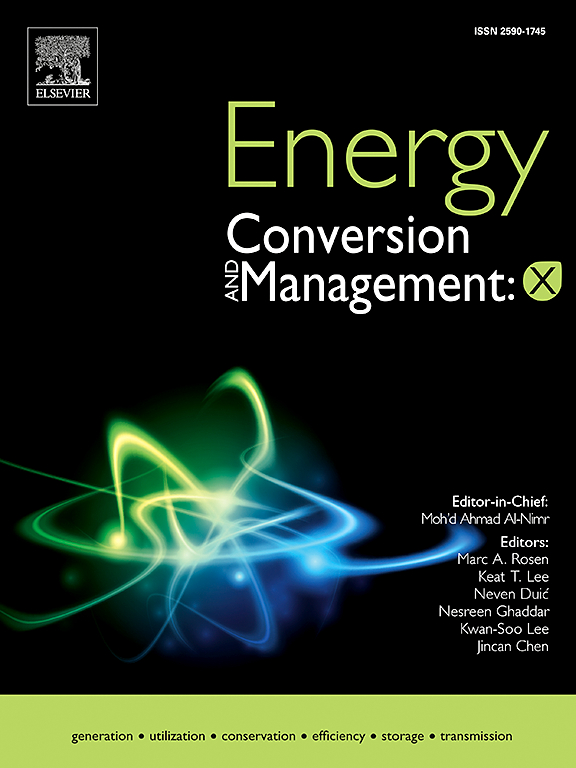基于神经网络的大宽度惩罚预测区间估计在可再生能源预测及系统中的应用
IF 7.6
Q1 ENERGY & FUELS
引用次数: 0
摘要
增加可再生能源的渗透给电力系统带来了巨大的不确定性。概率预测通过预测区间(pi)来量化这种不确定性,是指导发电运营储备准备的关键。备用发电资源的数量直接反映在PI宽度上,通常关注极端条件下PI宽度较大时出现的最坏情况。本文旨在通过提出一种新的基于PI的损失函数来减少较大的PI宽度,该函数在开发可再生能源预测模型时利用k个最大元素函数的和对较大的PI宽度施加更大的惩罚。该方法能够在模型训练过程中识别并减少较大的PI宽度,同时保证PI的可靠性。损失函数与基于梯度的算法兼容,允许与最先进的神经网络和最新的深度学习技术进一步集成。利用人工神经网络和LSTM模型对合成和太阳辐照度预测数据集进行的实验表明,我们的方法在保持预测精度的同时,在获得更窄的pi方面是有效的。对太阳能电力储备的成本分析表明,在高不确定性条件下,该方法减少了储备的过度分配,降低了供应和赤字处罚的总成本。这是由于改进了PI的下界,它更好地捕获了实际生成,从而减少了负载损失。此外,在稳健的能源管理中,与基准方法相比,使用PI信息评估的净电力成本范围表现出最小的变化,这是由于净负荷预测的PI宽度的保守性降低。本文章由计算机程序翻译,如有差异,请以英文原文为准。
Neural network-based prediction interval estimation with large width penalization for renewable energy forecasting and system applications
Increasing the penetration of renewable energy introduces significant uncertainty into power systems. Probabilistic forecasting, which quantifies this uncertainty through prediction intervals (PIs), is essential for guiding a generation operating reserve preparation. The amount of standby generation resources is directly reflected by a PI width and typically focuses on the worst-case scenario arising with large PI widths under extreme conditions. This paper aims to reduce the large PI widths by proposing a new PI-based loss function that utilizes the sum of the K-largest element functions to impose greater penalties on larger PI widths in developing a renewable energy forecasting model. The proposed methodology can identify and reduce large PI widths during the model training process while ensuring PI’s reliability. The loss function is compatible with gradient-based algorithms, allowing for further integration with state-of-the-art neural networks and recent deep learning techniques. Experiments on synthetic and solar irradiance forecasting datasets utilizing ANN and LSTM models showcase our approach’s effectiveness in attaining narrower PIs while maintaining prediction accuracy. A cost analysis of solar power reserve demonstrates that our method yields reduced reserve over-allocation and lower total costs for provision and deficit penalties under high uncertainty. This is due to an improved PI’s lower bound, which better captures actual generation, thereby decreasing lost load penalties. Furthermore, in robust energy management, the net electricity cost range assessed using PI information exhibits the narrowest variation compared to benchmarked methods due to the conservatism reduction in PI widths of net load forecasts.
求助全文
通过发布文献求助,成功后即可免费获取论文全文。
去求助
来源期刊

Energy Conversion and Management-X
Multiple-
CiteScore
8.80
自引率
3.20%
发文量
180
审稿时长
58 days
期刊介绍:
Energy Conversion and Management: X is the open access extension of the reputable journal Energy Conversion and Management, serving as a platform for interdisciplinary research on a wide array of critical energy subjects. The journal is dedicated to publishing original contributions and in-depth technical review articles that present groundbreaking research on topics spanning energy generation, utilization, conversion, storage, transmission, conservation, management, and sustainability.
The scope of Energy Conversion and Management: X encompasses various forms of energy, including mechanical, thermal, nuclear, chemical, electromagnetic, magnetic, and electric energy. It addresses all known energy resources, highlighting both conventional sources like fossil fuels and nuclear power, as well as renewable resources such as solar, biomass, hydro, wind, geothermal, and ocean energy.
 求助内容:
求助内容: 应助结果提醒方式:
应助结果提醒方式:


